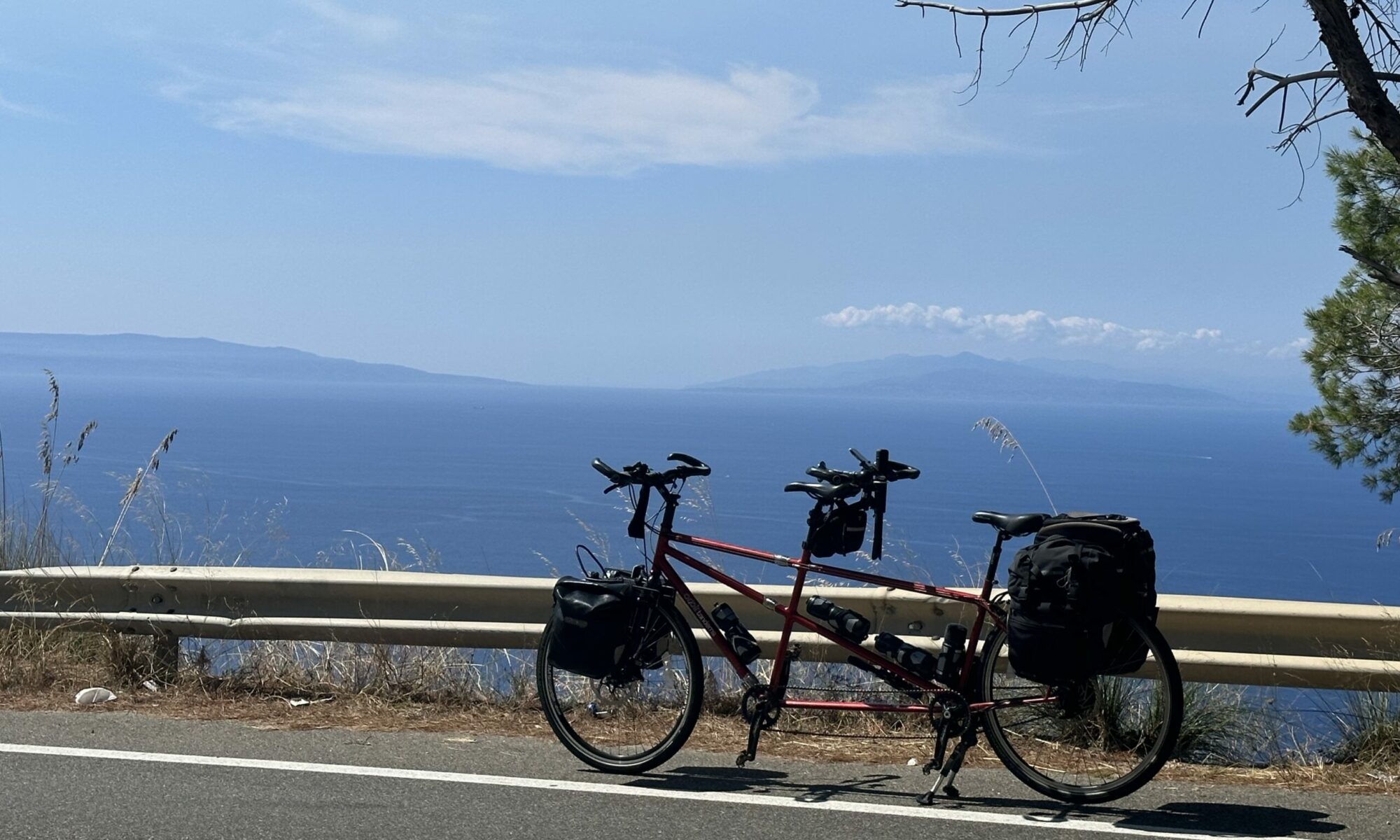Distance: 51.1 km
Time: 2 hours 46 minutes
Speed: 18.5 km/h
Ascent: 202 metres
Total distance: 1813.1 km
Total time: 96 hours 36 minutes
Wordle scores: Captain 5 and 4, Stoker 4 and 3
Word of the day: “ferragosto” (feh-rah-goss-toe) – the festival originated by Emperor Augustus, a day of rest on August 15th
The Stoker writes:
We were both really tired after the ride into Santa Maria di Leuca. Not so much from the day’s cycling, I think, but from having to pedal hard for the last hour to get to the check-in by 1pm. Had we had more time, we’d probably have stopped for a quick snack somewhere, but with no time to do that, we arrived at our lodgings pretty much running on fumes!
Francesco, who let us in, was so impressed that we’d cycled all the way from Trieste that he gave us a half-bottle of prosecco with which to celebrate, which was very lovely of him.
We went straight out for lunch in a nearby bar, and on the way back picked up provisions for dinner in the little supermarket. The Captain spent the early part of the afternoon tending to the tandem on our shady balcony – new brake pads, a change of oil in the Rohloff hub, and a general check round. All good. I caught up on our laundry and other packing related organisation. We also booked a boat trip for our rest day to see the caves and cliffs of the two seas, with our fingers crossed for a wind free day for it.
We ate on our little balcony, and spotted at least two firework displays nearby. Ferragosto is on the 15th August, a public holiday in Italy stemming originally from a day of general rest for agricultural workers after hard summer work in the fields. We speculated that the fireworks were early celebrations for that. With the lighthouse blinking red and white lights down at the port, we turned in.
Our rest day dawned fine and … oh, is that actual rain on the balcony? I’d left the washing out there, but it seemed unscathed, phew. Rain! Fancy that! We walked round to the port to find our boat, the Lady Leuca, and took our seats on the top deck. The boat departed at 10:30, only to turn immediately round to collect some late-comers. If it had been a British boat they would have been roundly tutted and had hard stares aimed in their direction, but this being Italy, no-one turned a hair!
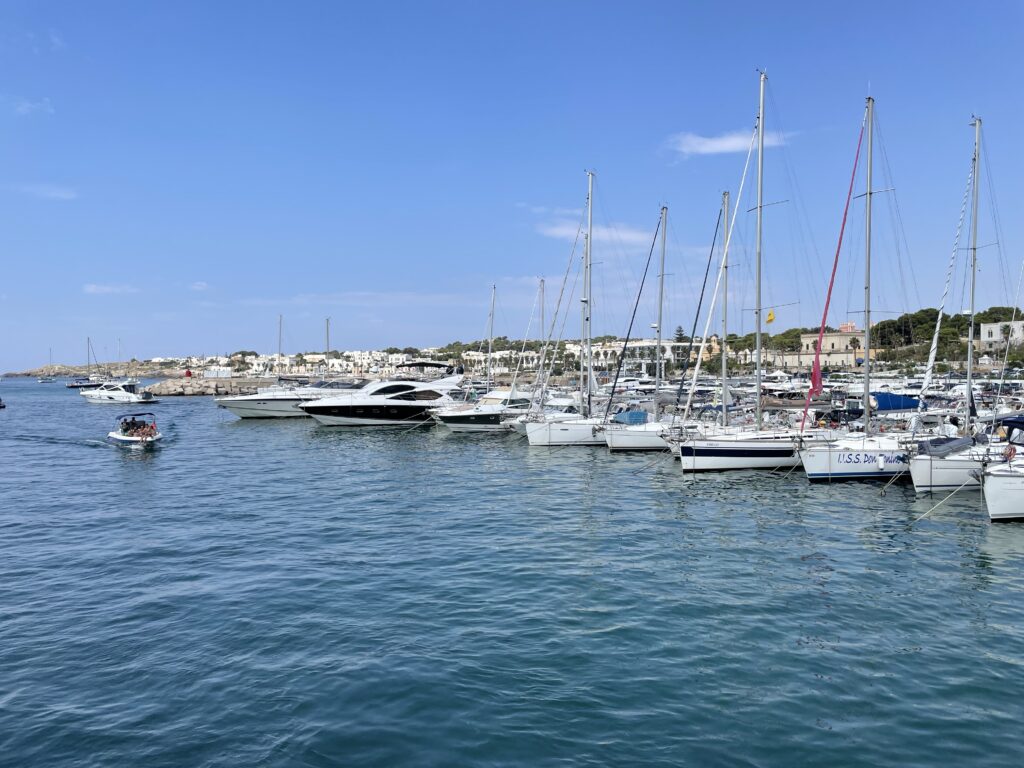
We set off past the lighthouse, which the commentary told us was the ‘lighthouse of the two seas’, although it doesn’t have that name on a map. The point on which it stands is the Punta Meliso, the official point at which the Adriatic turns into the Ionian Sea. At least it does if you’re travelling in the direction we are!
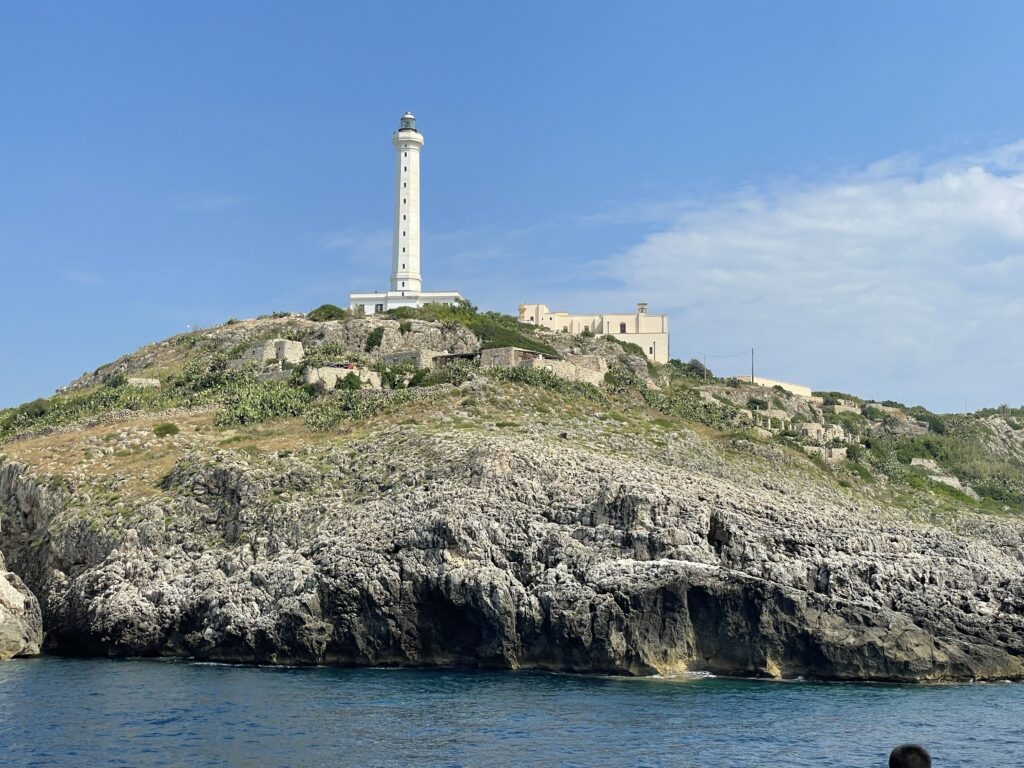
We pootled along the coast, with the commentary calling out the names of the caves and their distinguishing features. This one like a heart, with two chambers, that one like a face, and so on. They were impressively big, and we were told that underneath the water they extend much further, sometimes to the size of a cathedral underwater.
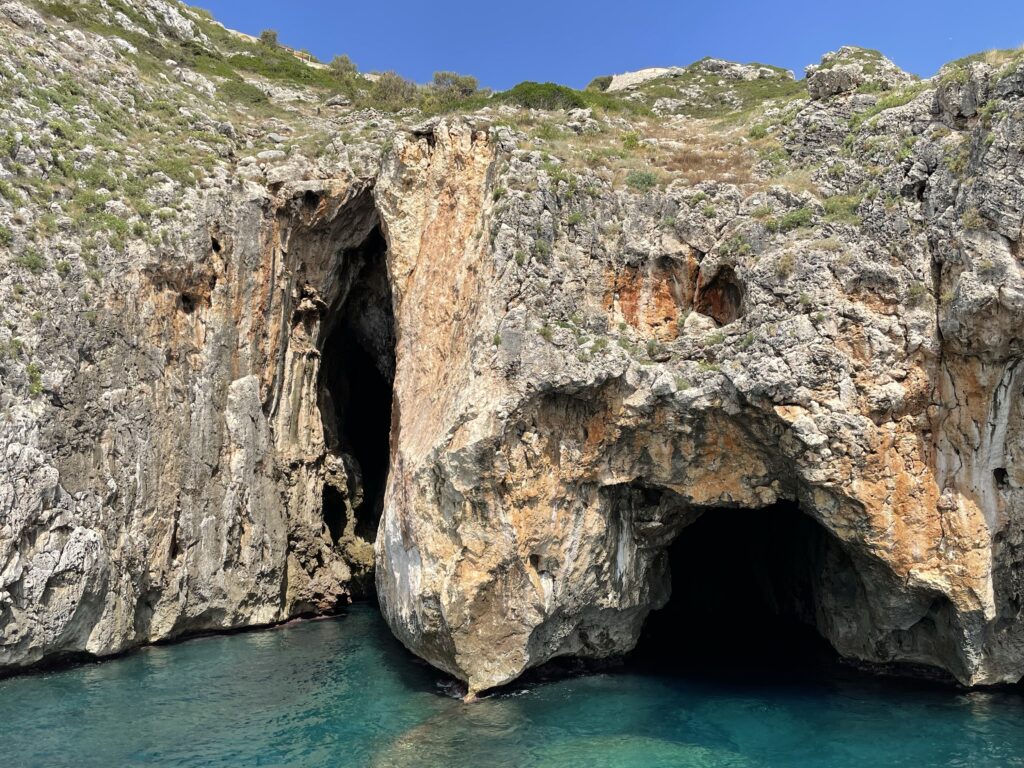
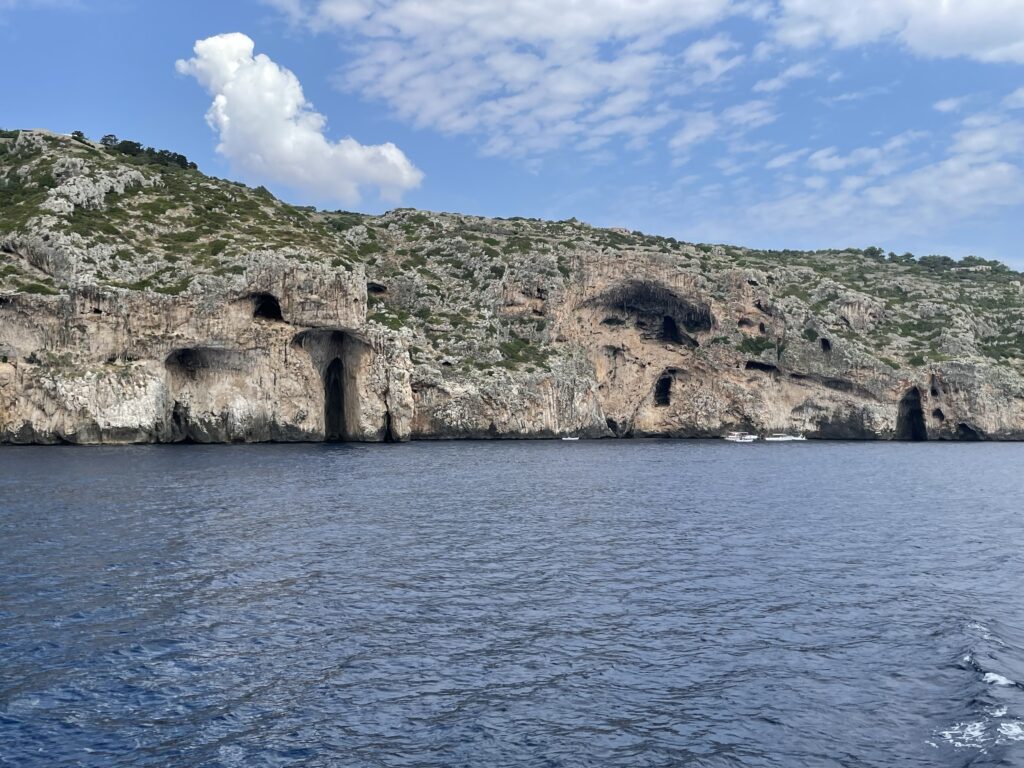
The commentary warned us that for some reason everyone’s phones would briefly connect to Greek mobile services, and sure enough they did! We are almost on a level with Corfu here, and it is less than two hours away by sea.
The boat turned back towards the lighthouse, across the imperceptible change of sea, and on to Punto Ristola, the southern-most point of Italy’s heel. There’s a flag and everything!
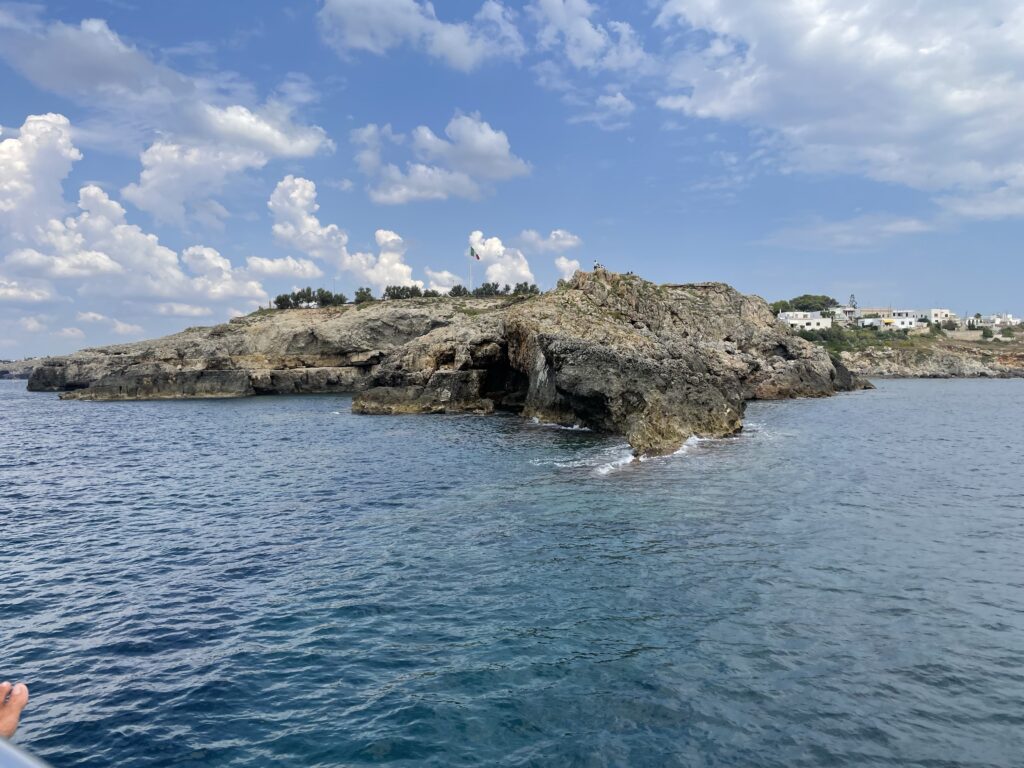
The caves on the Ionian side were less impressive, the cliffs were much less high, but there were some good formations. The boat anchored and we were allowed to swim in the sea for a bit, very exciting, our second sea of three on this trip. It was pretty warm, and with a queue of people to get in down the steps that was just as well, as I wouldn’t have been able to indulge my usual squealing acclimatisation routine.
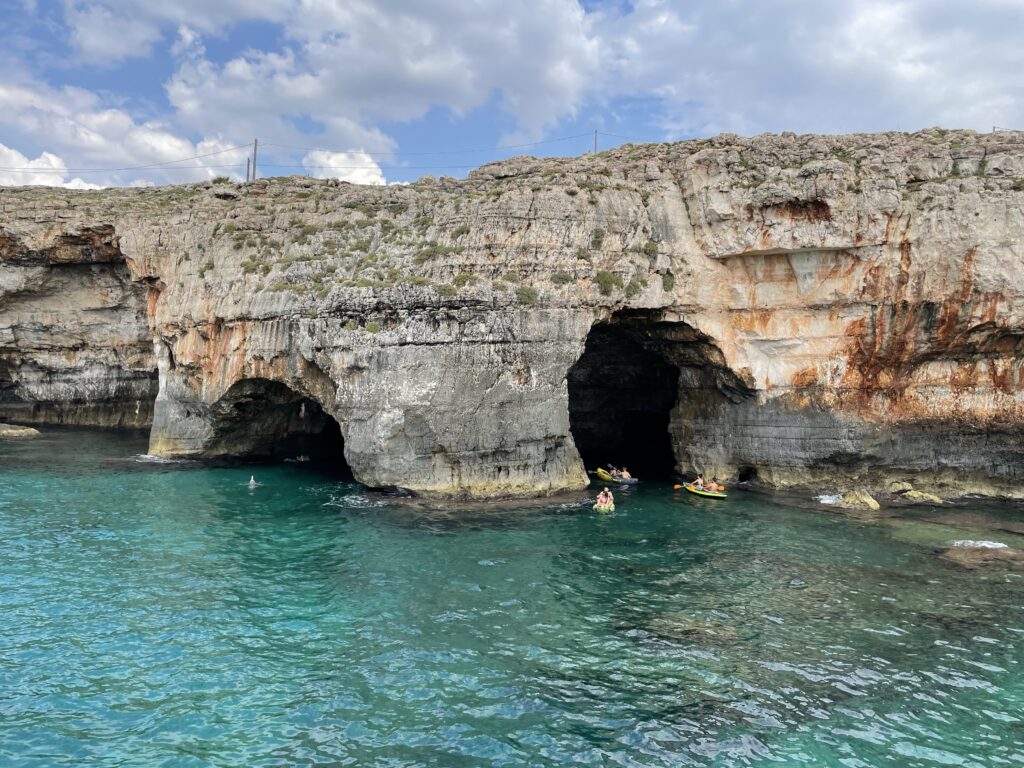
After the swim, we climbed back on board to be served an aperitivo and a crostino snack, while the boat took us back to the harbour. It was a great little trip, loads to see and the first dip into the Ionian Sea of the trip. The commentary on board had told us that the Ionian Sea is more salty than the Adriatic. I wondered why that might be – research indicates it is because of its general remoteness from land, which means it receives little or no fresh water in-flow.
Back to the apartment, then, for the rest of our rest day, some forward planning and route checking. We had a lovely meal in the evening at ‘Relax’, right on the sea shore, where we were informed that you must enter and leave with a smile, which wasn’t difficult!
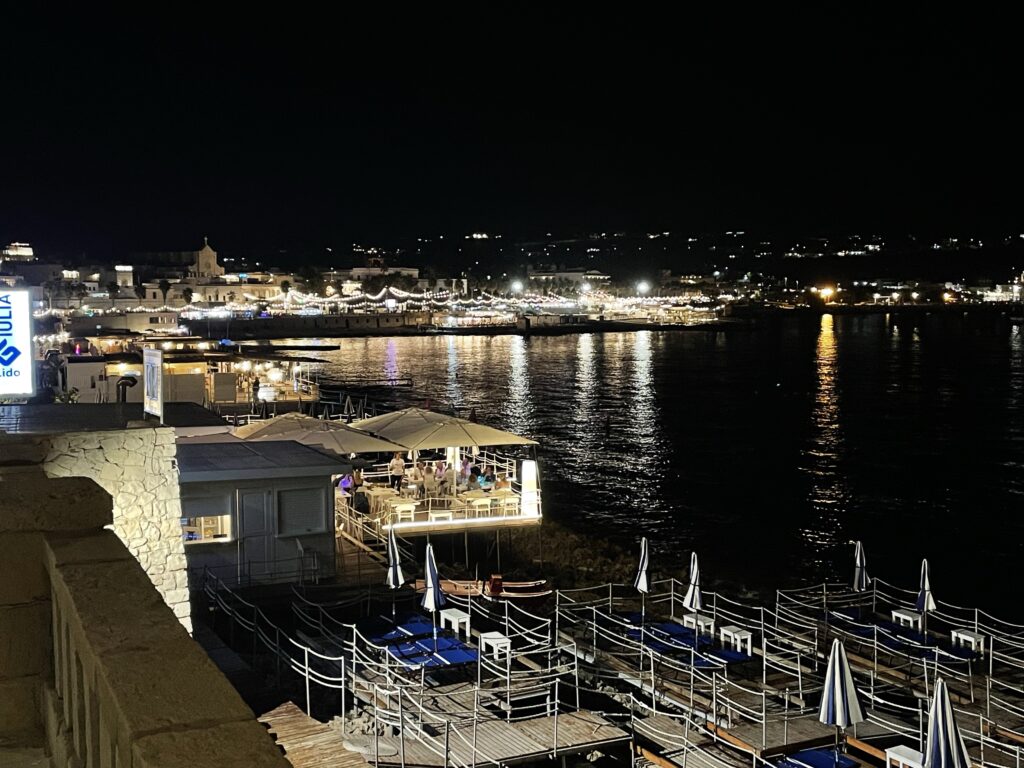
With just over fifty easy kilometres to do today (or so we thought!), we awarded ourselves a late start, and departed the apartment around 11am. As we left the brake cable snapped, and we got a bit lost on the way to breakfast, ending up at a flight of steps. Not a good start. At least they had tea at the cafe we did find! The Captain quickly realised that the brake cable had actually just slipped out of the connector, rather than snapping, and managed to get it back into position whilst I was finishing my tea and paying for breakfast.
A side note: it’s the convention in Italy that you order what you want in a café, and they bring it to where you are sitting, which may be distant from the serving and paying areas of the café, indeed often out of sight of them. You enjoy your chosen food and beverages, and then before you leave you pop back in to pay, whereupon they ask you what you had and you tell them, they tot it up and you pay. It’s very much a trust-based system, but it’s clearly not taken advantage of anywhere, which is rather admirable.
All issues resolved, we climbed on and began our first northerly pedalling since, well since Trieste, really. We quickly realised we were pushing into a strong headwind, which the Captain estimated was stripping around 5 kph off our speed. It was hard going, and I could see from the map that we would be going pretty much in the same direction all day, so it wasn’t going to ease any time soon. Nothing for it but to keep our heads down, try to resist the temptation to fight the wind, and pedal on.
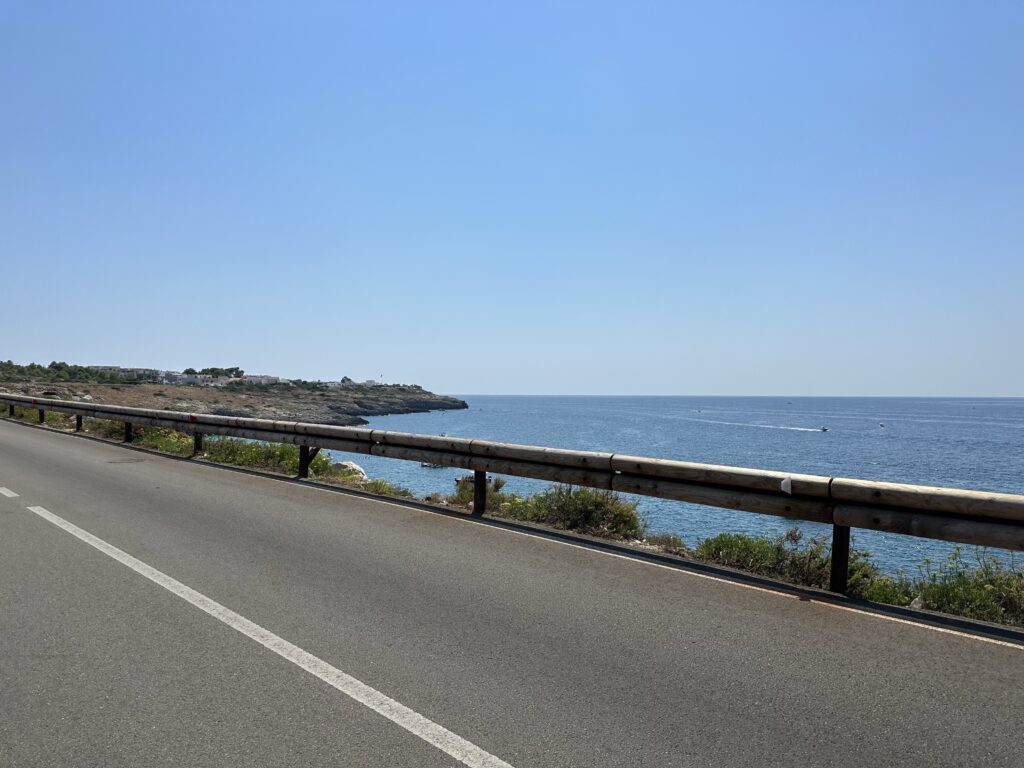
We stopped in the shady drive of a B&B for a drink after an hour, and agreed we’d need to find somewhere for lunch, or at least a snack, in another hour at most, rather than trying to make our destination, Gallipoli, and then eating. Back to it, then, and we battled on in quiet joint endeavour, slightly inland through the Ugento national park, some of which had clearly been burning very recently.
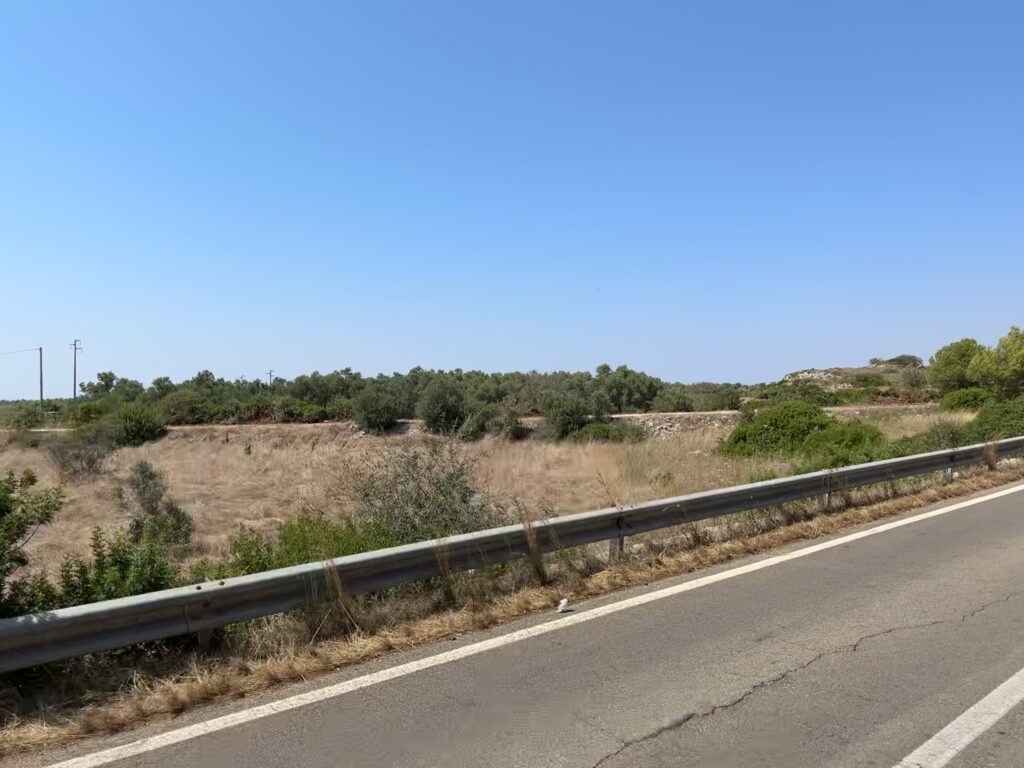
We turned towards the coast again and stopped at a Lido for fuel and water. Cycling by the coast has made it very easy to find eating places, as there are countless beach clubs, each with its own restaurant or snack bar, and they were all open even today, what with all the people who had come to the beach for Ferragosto.
Just under the psychologically important 16km to go (ten miles 😉), fuelled by arancini and pucce (the Puglian pizza bread sandwiches), things seemed a little easier, and we made good progress for a few kilometres. We turned off onto a section of minor road by the beaches, and it was all going fine until we met the bin lorry, and the tail of traffic it had built up. There must have been thirty cars behind it, some sitting patiently, some beeping very impatiently! There was no way through with the bike, we just waited it out in the shade, and then wheeled through carefully when things started moving.
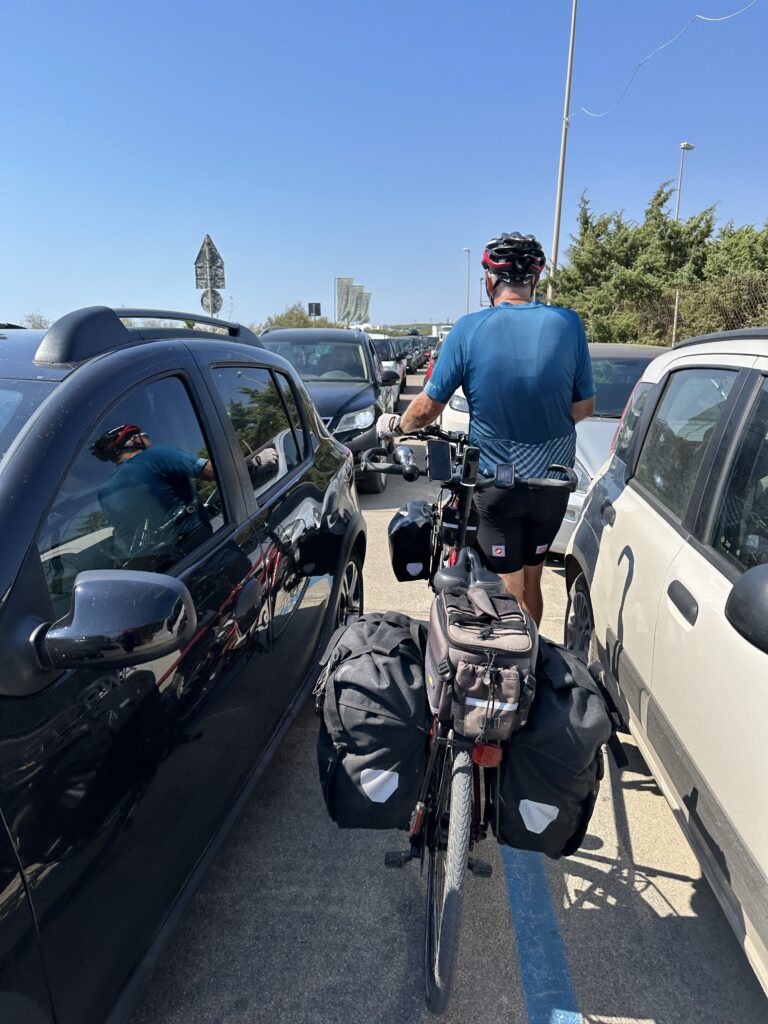
Gallipoli appeared in view…
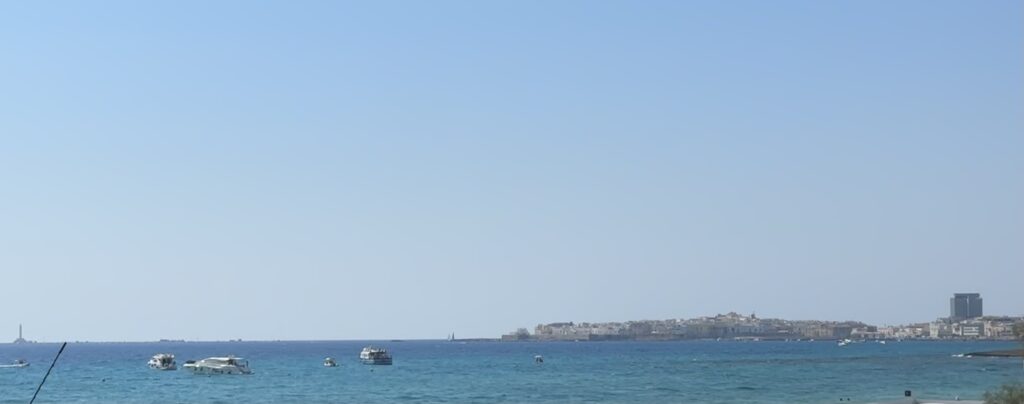
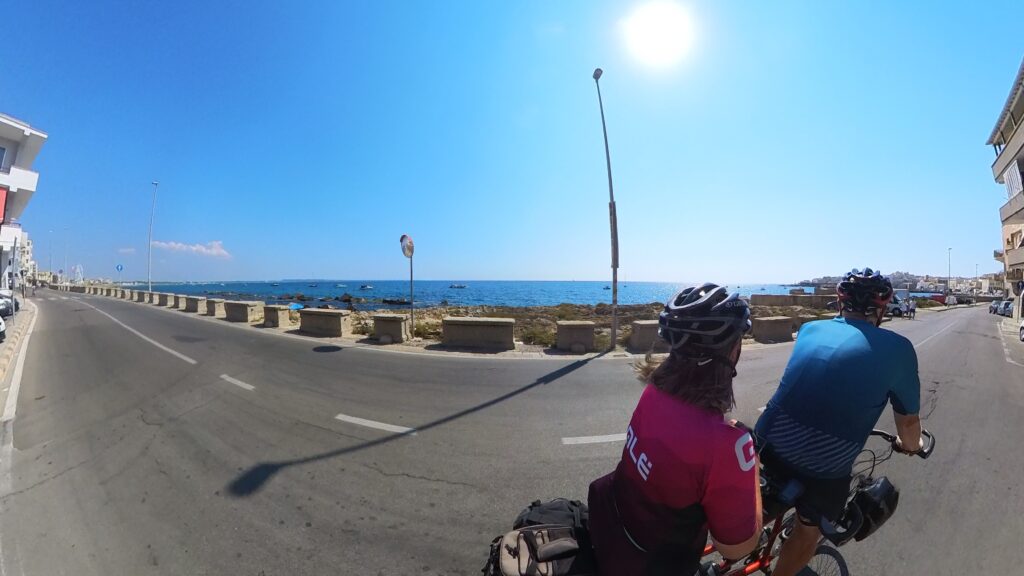
… and we worked our way around towards the bridge onto the island section of town, the oldest part, where our lodgings are situated. It’s guarded by an Aragonese castle.
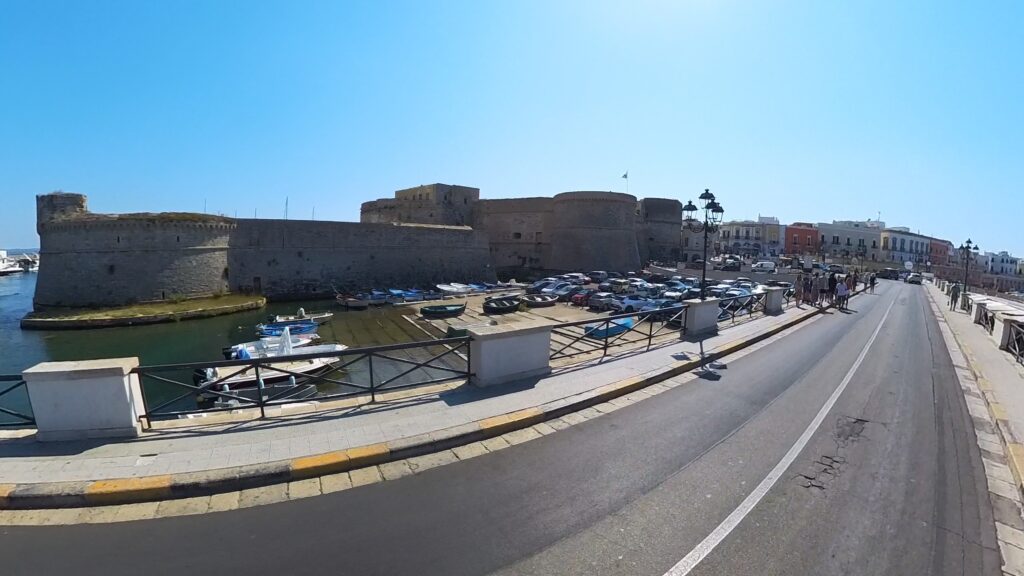
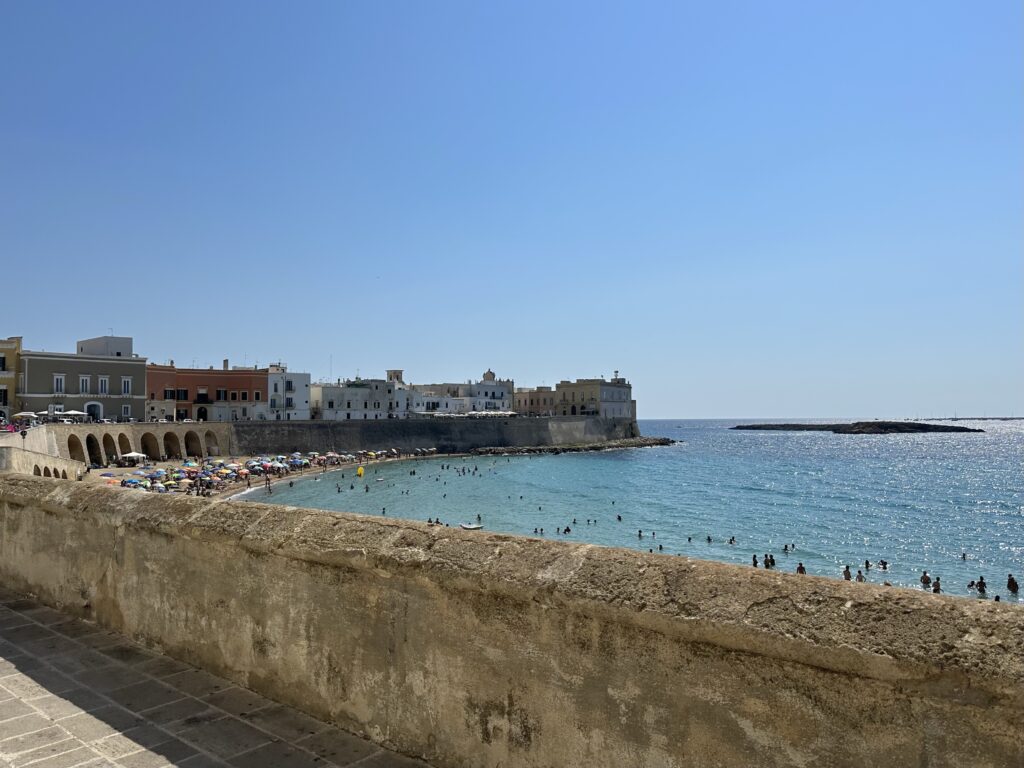
Finally, we rolled up outside, and climbed off with great relief. We’ll spend another rest day here tomorrow, there’s lots to see. It’s not the Gallipoli everyone knows from the horrendous fighting during the First World War, by the way – that is in the Dardanelles in Turkey. Which was news to me, I’m ashamed to say! ‘Gallipoli’ means ‘beautiful city’ in Greek, so it’s probably not surprising that there’s more than one.
Here’s today’s route and a short video
